When we cleared the slope for the orchard, we cleared a small area that had been choked with vegetation, including a number of invasive species, and dead, or diseased trees. This resulted in much more sun reaching the slope, and a significant amount of soil disturbance.
Since the deer fence was installed, and the trees were planted, we’ve battled a succession of pocket gophers, and meadow voles, invasive bull thistles, and French broom, but overall, a few years further on, the orchard is now thriving, the trees are maturing, and many of them are starting to set fruit.
This year though, we seem to be battling a new thug at the base of some of our fruit trees. Sheep Sorrel (Rumex acetosella).
Sheep Sorrel, also known as Red Sorrel, is a short-lived perennial herb in the Buckwheat Family (Polygonaceae) that is native to Eurasia, and is thought to have been introduced to the United States around the mid-late 19th Century. When it arrived isn’t really that important, as this common weed is now distributed throughout the United States and Canada, in fact throughout much of the Northern Hemisphere.
In California, Sheep Sorrel is most pervasive in Northern and Central California.
The California Invasive Plant Council (Cal-IPC) classifies Rumex acetosella as moderately invasive, as this species is capable of displacing native grasses by shading, and smothering. Sheep Sorrel is known to compete with important native host plants used by some endangered butterfly species in the Bay Area. [1] It is also suggested that Sheep Sorrel is non-mycorrhizal, and may potentially eliminate soil mycorrhizae in areas where large dense stands of plants occur.
Sheep Sorrel favors growing in moist, low-fertility, acidic, fast-draining soils, and is commonly found in open, sunny annual grasslands, and meadows. Sandy or gravelly soils are especially favored. It is frequently found in recently disturbed soils, and in areas that have recently been burned.
Some farmers cultivating Blueberries struggle with Sheep Sorrel as Rumex acetosella favors similar growing conditions. For some crops, the presence of Sheep Sorrel in soils may be used to suggest when soils need liming to increase soil pH, although liming alone is not sufficient to control Sheep Sorrel growth.
Needless to say, installing our irrigated orchard in the midst of a coastal mixed-evergreen woodland, on a recently cleared sandy slope, with acidic surface soils, has set up the perfect conditions for Sheep Sorrel growth here.
Identification:
Sheep Sorrel is a relatively unassuming plant, that grows from 4 to 18 inches in height. Its distinctive arrow shaped leaves somewhat resemble a fleur-de-lis, and occur as a basal whorl beneath the flowering stems, although stem leaves are occasionally also observed.
Above the leaves tiny flowers appear on erect stems that branch at the tips.
Stems are ridged, and may be green or maroon-tinted, depending on stage of growth. Flowers may also be green or maroon-red in color.
The flowers darken, and become more red, with age.
Rumex acetosella reproduces both by seed, and from creeping rhizomes. A single plant can reportedly produce up to 1,600 seeds, which are rust-brown in color, and may remain viable in undisturbed soils for decades. [2] Needless to say, this is NOT a plant to add to the compost pile!
Seeds may be consumed, although not digested, and subsequently distributed, by birds and small mammals.
Management:
One recommended method of Sheep Sorrel control is hand pulling, and up until now, this is the method we’ve employed. It’s laborious, and requires frequent revisiting to an area to keep growth in check. The challenge with hand pulling, other than being labor intensive, especially for large stands, is that any root and rhizome fragments left behind have the potential to resprout. Pulling also disturbs surface soils, and may encourage germination of dormant seeds. As such, hand-pulling is usually only recommended for small stands, and young plants. Mature plants can develop extensive fibrous root systems making complete and effective hand removal difficult.
It’s fair to say that mechanical removal has not worked for us. In fact, the problem is significantly worse than it was a couple of years ago. When I first found Sheep Sorrel in the orchard 2 years ago, the patch of growth was less than a square foot, immediately adjacent to a recently planted apple tree. I set to work to remove it, and repeatedly pulled new growth as it appeared. Despite attempting to hand pull it numerous times since then, it has continued to resprout, and spread, with a vengence, and the patch is now approximately 150 square feet in total, over two areas, and continuing to spread. Clearly we need an alternate strategy for control.
Although we have goats, grazing is not recommended due to the high oxalate concentrations in Sheep Sorrel, which can be toxic to some species of livestock, and wildlife, when consumed in large quantities. Our goats are well fed, so it’s unlikely a little grazing would bother them, but Sheep Sorrel isn’t particularly palatable to livestock. As our goats are spoiled, they’d have absolutely no incentive to give these weeds so much as a sideways glance. That’s not a bad thing though, as much like hand-pulling, grazing can also result in soil disturbance, encouraging dormant seeds to sprout, and result in seed, and rhizome, redistribution.
Deer, however, are known to browse this species, and it’s possible our robust deer populations have been helping to keep this weed in check outside of the orchard, as thus far we’ve only found it growing within the perimeter of the deer fence.

This spring, our resident deer population has expanded...again! Including the addition of this pair of twins.
Repeated cultivation can also reportedly control Sheep Sorrel as continued removal of top-growth will eventually starve the roots.
Herbicides are frequently, and successfully used to control Sheep Sorrel, but as we don’t use herbicides in our orchard, we need to find alternate means of effective organic control.
A study regarding suppression of weeds around organic highbush blueberry plantings suggests that some mulches may successfully suppress the growth of Sheep Sorrel, including manure-sawdust mulches, both through mechanical suppression due to mulch thickness, and also through alteration of surface soil pH. [3]
As we frequently source large quantities of such material from a nearby stable to augment our own compost with, this is a method we’re interested in trying, providing it doesn’t provide too much cover for voles of course. We don’t mulch extensively here, primarily to reduce cover for rodents, but as the Sheep Sorrel is relatively contained at the moment it might be worth trying to smother it. Hand pulling around the trunks of the trees though will still be necessary, especially around this Honey Crisp apple, which is where this problem originated.
Our strategy will be to remove the existing plants as best we can now the weather is warm and dry, and the rains have ceased for the season. After cultivation, we’ll leave the area exposed, long enough for the surface soil to dry out thoroughly, so any disturbed roots left behind will dessicate. Cultivation during wet weather, or in damp soils, can encourage rapid regrowth.
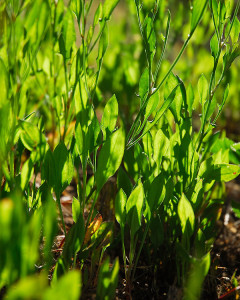
If the manure-sawdust mulch works, we're hoping to see a LOT less of this in the orchard next spring
We’ll then apply the mulch generously to the areas in the orchard where the Sheep Sorrel is currently gaining a stronghold. We won’t eliminate growth, but even if the rate of spread is slowed, and the mulch eases the removal of the plants when young, it may help us to finally get on top of this problem before it really spreads out of control.
Maybe then we’ll have time to develop a strategy for outsmarting our exploding squirrel population, before they abscond with the remaining crop of Apriums this spring!
———————–
[1] Plant Assessment Form for Rumex acetosella. California Invasive Plant Council.
[2] Weed of the Week ‘Sheep Sorrel’ (Rumex acetosella L.)
[3] Burkhard, N. and Lynch, D. 2009. Organic Mulch Impact on Vegetation Dynamics and Productivity of Highbush Blueberry Under Organic Production. HortScience vol. 44 no. 3 688-696.
[4] Fitzsimmons, J.P., and Burrill, L. C. 1993. Red Sorrel (Rumex acetosella L.) Pacific Northwest Extension Publication. PNW 446. March 1993.

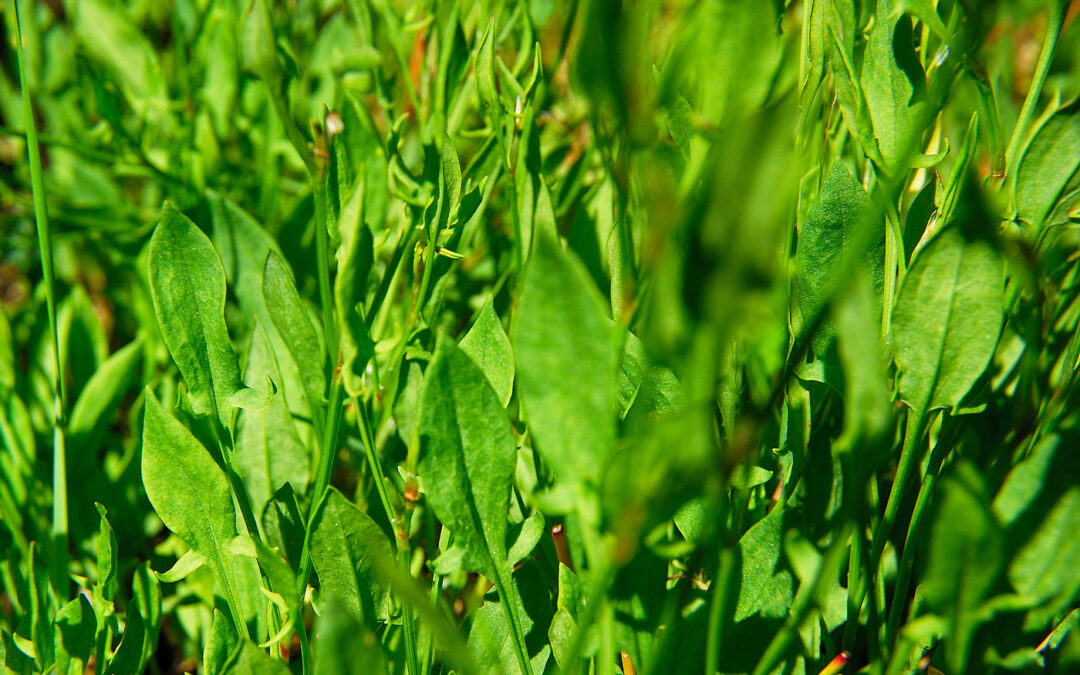
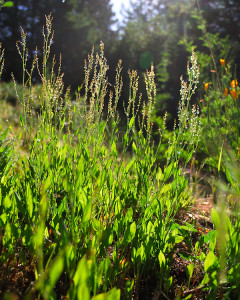
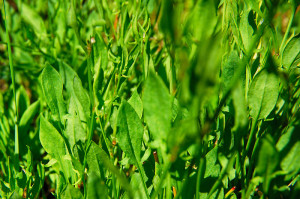
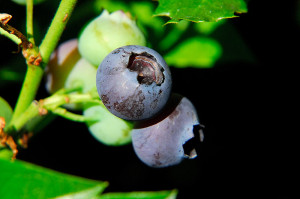
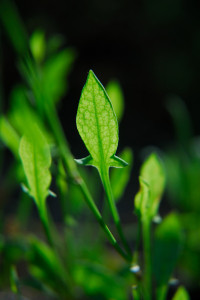

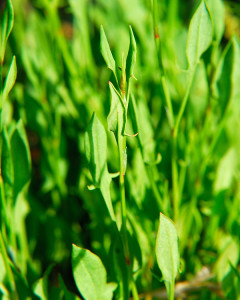
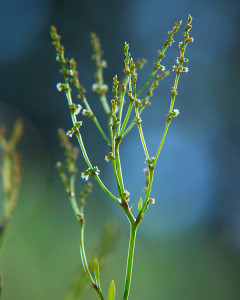
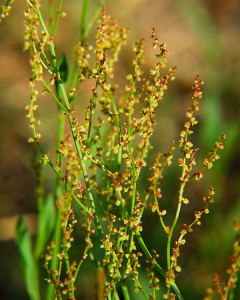
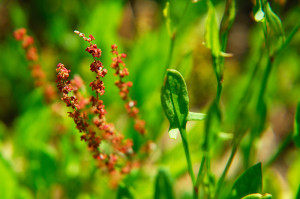
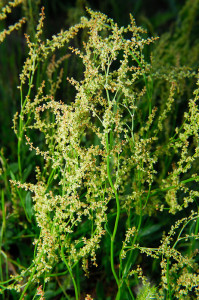
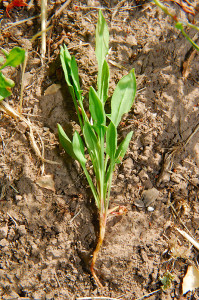

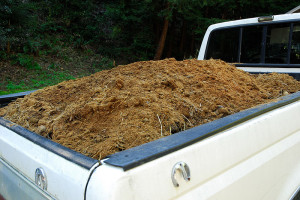
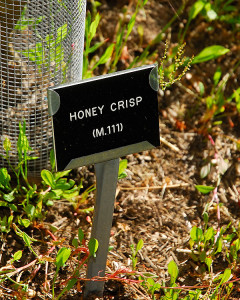







Yikes – one I’ll be keeping an eye out for – thanks for the warning. I haven’t seen it or not much? I suspect the deer might be keeping it down as we seem to have similar conditions to the ones you describe as ideal for this nasty!
Honestly , it was easier to get rid of the French Broom! I noticed a large patch of Sheep Sorrel down on the main road the other day as I was driving by, right next to a small forest of French Broom. I wouldn’t have even seen it, except that it’s blooming right now, and the sun was catching the flowers just right. As it’s distributed by birds, even if I get this area under control, it seems we could easily become reinfested 🙁
Yikes is right! Good luck fighting the good fight.
Thanks! Sheep Sorrel is stubborn…but so am I 😉
Oh dear. Now all you need is Bermuda Grass to complete the invasive weed experience. I’ll be watching your suppression story with interest.
No kidding! We do have Brome grass, that’s bad enough, but if we end up with Bermuda grass, we may have to move 😉
As soon as I saw the name of this post I had to read it. We’ve got a HUGE problem with this stuff. I had no idea what it was at first until another blogger ID’d it for me. It grows on almost every square inch of our property and is awful stuff to try and dig out. The roots are like elastic bands but more breakable. I don’t think I’ll ever be rid of it but it was interesting to read about the soil it likes as this would essentially describe the soil in my garden. I’ll be keeping an eye on your eradication efforts to see if anything works.
Ugh Marguerite, I’m sorry you have so much of this. On a large scale, I really don’t know what would be practical in the way of control, other than repeated cultivation in dry weather. I honestly think that once you find you have Sheep Sorrel, you have to accept that living with it, at least some of it, is inevitable. My fear is that if I don’t squash it now, I’ll be in the same boat!
Wow, there’s always one more weed, isn’t there? I didn’t realize what a problem this could be – I believe when I was a kid we used to eat the leaves of this plant, they are sour and good for the digestion (in moderation). But here it seems to get out of control quickly. The usual thing…
The leaves are somewhat edible, and this plant does have its uses, but I’d never cultivate it on purpose. Honestly, I think I’d rather have bindweed (which used to run amok in our last garden). Actually, if I’m honest, I’d rather have NO weeds 😛
This weed sounds like it has adapted a little too well! I hope you find the answer to your problem. I was wondering about smothering it with cardboard, although if the seeds are viable for decades, that may not help either. Good luck!
I thought about cardboard too, if only to deprive the roots and leaflets of solar energy. However, with the slope, I was afraid the cardboard would become a toboggan for the mulch, and slide down the hill 😉 I could really envision all the mulch just sliding on to the farm road! As much as I hate the stuff, I might use a patch of weed blocking fabric under the mulch though, just for a little extra weed suppression. I’m a bit concerned that a manure-sawdust mulch might just make all the other weeds there a little too happy!
Well Clare you have just identified my latest nemesis in the garden. I don’t where it came from but it appeared and has already flowered. Looks like we will be hand pulling from beneath the trees and then mulching. This weed is invasive in NY and known to cause hay fever…which could be why I am sneezing when outside. I feel your pain. Just wish the deer would eat it instead of my plants.
I’d read it can wreak havoc with allergy sufferers. I’m allergic to so many things here, I’m not sure I could tell the difference 😉 If someone could develop a deer-training program, to encourage them to eat what we don’t want around here, like the sorrel, I’d be thrilled!
This plant has medicinal qualities, no? Hopefully you get it under control, but like you mentioned, maybe living with it is the only option. With our dry weather, it may not be quite so happy and move on to moister climes.
It is thought to have anti-inflammatory, and anti-cancer properties. However, that said, even for humans it can in sufficient amounts lead to renal and hepatic damage. Our weather is very dry here in the summer, and it isn’t as big an issue outside of the irrigated areas. Our greatest problem is around the fruit trees, where it benefits from supplemental water during the dry season. Although it does seem quite drought tolerant, and areas that die back away from the trees over summer, do resprout with the return of the rains.
Oh my! What a terrible weed! And to have to put down mulch, which might attract voles. That is a quandary! I hope you get it under control!
The voles really complicate things here. I’d use much more mulch here, if only for water conservation, if it weren’t for the voles. I’m hoping the composition of manure-sawdust will be less attractive to them, than something like a loose straw or wood-chip mulch though, we’ll just have to keep an eye on the mulched areas.
hello Clare, like Marguerite when I saw your title I had to read, I have it dotted around my garden and it is native here (Scotland) but I quickly learnt it was one to pull or at least chop down when ever I find it, when I’ve cleared areas of my garden of tough grass this weed and horsetail are the next toughest to get rid of, so sorry you have it in your orchard, I too was thinking maybe to put something under the mulch but I didn’t realise the orchard is on a slope which does make it more difficult, I have found changing the PH a little with lime has made a small difference with some of the problem plants, good luck, Frances
We have native plants here that can develop small thickets of growth too. Not all natives are saintly in the garden, just as not all exotic plants are problematic. This is a plant here though that is remarkably well adapted to growing here, and doesn’t play well with other plants. We are going to try liming a little too, just in these areas. But first we need to do a soil pH test so we don’t apply too much!
It’s always surprising to see that one of ‘our’ natives is described as an invasive species somewhere else…
Sheep sorrel is one of those tiny little plants that add some extra color to those poor meadows in my region. It’s spreading yes, but can’t be called invasive at all ;-)… here at least…
Probably it sounds as weird to you to hear Black Cherry (Prunus serotina) or Red Oak (Quercus robur) described as invasive…
I’m glad to have sheep sorrel in my garden, as it is a host to Lycaena phlaeas, the Small Copper butterfly, one of those small butterflies that make a flower meadow even more beautiful…
It doesn’t sound weird to me all. Plants growing outside of their native regions, that have the capacity to take over vegetated areas, are most certainly invasive, regardless of origin. In most areas here, it may not be that large a problem, but when it’s found growing in sensitive habitats, and crowding out host plants for endangered species, that’s most definitely a problem. For me, it’s more an annoyance 😉 Where this is growing on the slope, it’s already completely smothered the native annuals that were there last year. Nothing else grows where this is growing.
Is there no end to the problems on your farm? No, of course not. But I may have the solution to this one. I have found solar sterilization to be highly effective in ridding soil of problem plants and seeds. Lay down some thick plastic sheeting. Black raises the temperature the best. Stake it down with landscape staples. Leave it in place for (can’t remember, but I think six weeks), then remove. You could save money by using one piece of plastic repeatedly, but it does degrade in the sunshine and probably couldn’t be used more than twice. The temperature will get up to 140-160 F under the sheeting and will kill everything. Probably wouldn’t be good for roots of your apple trees, so be careful where you put it. It isn’t a cheap solution if you have acres to sterilize, but it is highly effective, non-toxic, and organic. I used this technique with good results in my wildland restoration work. Good luck.
I’ve never seen this growing in our locality but had to ID it for a lady a few months ago. She is having a dreadful time with it and she’s at the point of dispair. It’s taking over her garden and has even spread under a large concrete path and is now on the other side.
I really hope that mulch works Clare for you.
I don’t think I have this but the flowers do look familiar. I will be on the lookout after your post especially the description of how fast it spreads.
I don’t know what sheep sorrels are, but our most scary and invasive weed that really scares me because of the thorns is the Mimosa pudica. It grows very fast and the leftover roots also grow. And i realized it is being grown as ornamentals in temperate countries.